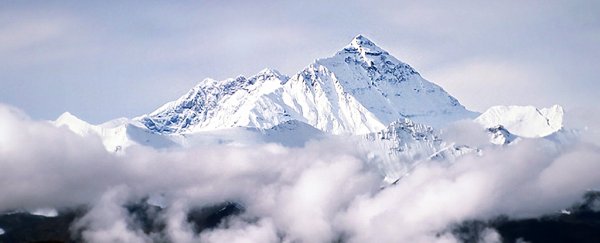The climate crisis enveloping Earth impacts the lowest depths of the sea and the most remote parts of the planet. And new research shows that it's also causing change at the highest points of the world.
Scientists studying South Col – Mount Everest's highest glacier – have reported that rapid ice loss is occurring as global temperatures rise, with ice further exposed and vulnerable due to the thinning snowpack cover.
That will make scaling Mount Everest more challenging due to the exposed bedrock. More worrying is the potential impact on the people who rely on these glaciers to supply water for drinking and agriculture. Increased risk of avalanches is another concern.
 (Mariusz Potocki)
(Mariusz Potocki)
Above: The South Col glacier ice core sample location (red arrow) and the Balcony weather station (yellow arrow).
"Climate predictions for the Himalaya suggest continued warming and continued glacier mass loss, and even the top of the Everest is impacted by anthropogenic source warming," says glaciochemist and the study's first author Mariusz Potocki from the University of Maine.
Using data from weather stations and ice samples – including an ice core taken from an elevation of 8,020 meters (26,312 feet), the highest ever for such a sample – the researchers' models show that several decades of accumulated ice are lost every year.
Snow cover loss is critical, the team reports. As sublimation happens – the direct transition of snow to vapor accelerated by climate change – the ice below is exposed further, with less solar radiation reflected back. The study estimates that around 2 meters (6.6 feet) of water is lost every year.
The new research is part of the ongoing 2019 National Geographic and Rolex Perpetual Planet Everest Expedition, tasked with investigating how climate change is affecting South Col and the wider Hindu Kush-Himalaya network of glaciers.
"It answers one of the big questions posed by our 2019 NGS/Rolex Mount Everest Expedition – whether the highest glaciers on the planet are impacted by human-source climate change," says glaciologist Paul Mayewski from the University of Maine.
"The answer is a resounding yes, and very significantly since the late 1990s."
Around 55 meters (180 feet) of glacier thinning has happened in the last 25 years, the researchers' models estimate, which is some 80 times faster than the ice formed over the previous couple of millennia. While the changes have been most intense over Everest since the late 1990s, the shifts triggered by a warming climate look to have been happening since the 1950s.
Besides warming temperatures, the scientists point to declining relative humidity and stronger winds as reasons for so much snow being lost; the snow is currently disappearing at a much faster rate than it's being replaced.
That this is happening at the highest point of the globe is a warning for glaciers worldwide as temperatures rise. Forecasts suggest that the trend is only going in one direction, and even glaciers as high as South Col could vanish by the middle of this century – another stark reminder of how we've permanently changed the face of the planet.
"Everest's highest glacier has served as a sentinel for this delicate balance and has demonstrated that even the roof of the Earth is impacted by anthropogenic source warming," write the researchers in their published paper.
The research has been published in NPJ Climate and Atmospheric Science.
